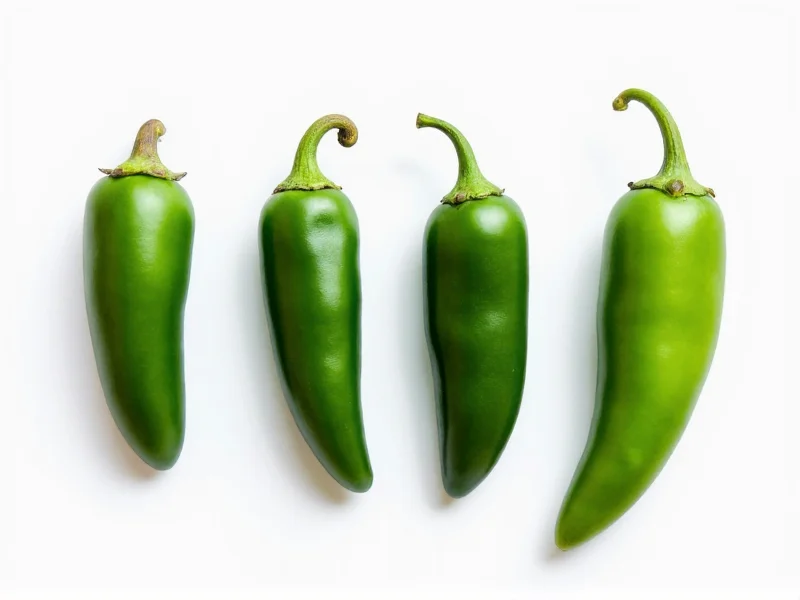When comparing serrano pepper versus jalapeño, understanding their distinct characteristics helps home cooks and chefs make informed decisions for recipes. Both belong to the Capsicum annuum species but differ significantly in heat, flavor, and culinary applications. This comprehensive comparison examines every aspect that matters when choosing between these popular chili peppers.
Heat Level: The Fundamental Difference
The most significant difference between serrano and jalapeño peppers lies in their heat intensity. Serranos consistently deliver more fire, making them a better choice when you need pronounced spiciness without overwhelming flavor complexity.
| Pepper Type | Scoville Heat Units (SHU) | Relative Heat | Heat Consistency |
|---|---|---|---|
| Serrano Pepper | 10,000-23,000 | 2-4x hotter than jalapeño | More consistent heat level |
| Jalapeño Pepper | 2,500-8,000 | Baseline for comparison | Varies significantly by growing conditions |
Understanding serrano pepper heat compared to jalapeño is crucial for recipe success. A single serrano often equals 2-3 jalapeños in heat intensity, but this varies based on growing conditions, ripeness, and even individual pepper variation. The white pith and seeds contain most capsaicin, so removing these reduces heat in both varieties.
Physical Characteristics and Appearance
Serrano peppers and jalapeños differ visibly in several ways that help with identification:
- Size and shape: Serranos are smaller (1-4 inches) with a straighter, tapered shape, while jalapeños are larger (2-4 inches) with a more bulbous, curved form
- Wall thickness: Serranos have thinner walls, making them less suitable for stuffing but better for sauces
- Color progression: Both start green and ripen to red, but serranos may also turn orange, brown, or purple when mature
- Surface texture: Serranos typically have smoother skin compared to jalapeños' characteristic striations (corking)
Flavor Profiles Beyond Heat
While heat differences dominate serrano pepper compared to jalapeño discussions, flavor nuances matter equally in culinary applications:
Serranos deliver a bright, grassy, almost herbal flavor with citrus notes that complements their intense heat. This makes them ideal for fresh salsas, pico de gallo, and sauces where you want heat without overwhelming sweetness.
Jalapeños offer a more complex flavor profile—earthy, slightly sweet, and vegetal with grassy undertones. Their thicker walls provide more substantial texture, making them perfect for stuffing, pickling, and roasting. The distinctive corking on jalapeños indicates maturity and often correlates with sweeter flavor.
Culinary Applications and Best Uses
Knowing when to use serrano versus jalapeño transforms your cooking results. Each pepper shines in specific applications based on their structural and flavor properties.
When to Choose Serrano Peppers
- For authentic Mexican salsas verde and roja where intense heat is traditional
- When making hot sauces that require clean, straightforward heat
- In ceviche or fresh seafood dishes where bright, grassy notes complement fish
- When you need consistent heat without the sweetness of jalapeños
When to Choose Jalapeño Peppers
- For stuffed peppers (ranchero style, poppers) due to thicker walls
- In pickled preparations (escabeche, jalapeño coins) where texture matters
- When roasting for chiles rellenos or adding smoky depth to dishes
- For milder heat with more complex flavor in everyday cooking
Substitution Guide: Serrano for Jalapeño and Vice Versa
Understanding serrano pepper substitution for jalapeño prevents recipe disasters. These guidelines help maintain intended heat levels:
- Using serrano instead of jalapeño: Start with half the amount called for, then adjust to taste. Remove seeds and membranes to reduce heat further.
- Using jalapeño instead of serrano: Use 2-3 times the amount, but recognize you won't achieve the same heat intensity. Consider adding a pinch of cayenne for additional kick.
- For canning/preserving: Jalapeños maintain texture better, while serranos may break down more in liquid.
- For drying: Both work well, but dried serranos (called chiltepin in some regions) deliver more concentrated heat.
Growing Considerations for Home Gardeners
If you're growing your own, serrano pepper compared to jalapeño cultivation reveals important differences:
- Maturity time: Serranos typically mature faster (65-80 days) than jalapeños (70-85 days)
- Plant size: Serrano plants grow taller (up to 4 feet) with more upright growth habit
- Yield: Jalapeño plants generally produce more peppers per plant
- Climate preference: Serranos handle heat better, while jalapeños may struggle in extreme temperatures
Nutritional Comparison
Both peppers offer similar nutritional benefits as members of the nightshade family, but with slight variations:
| Nutrient (per 100g) | Serrano Pepper | Jalapeño Pepper |
|---|---|---|
| Calories | 32 | 29 |
| Vitamin C | 165mg (275% DV) | 118mg (196% DV) |
| Vitamin A | 570IU | 1990IU |
| Dietary Fiber | 3.4g | 2.8g |
| Capsaicin Content | Higher | Lower |
Serranos contain slightly more vitamin C and capsaicin, while jalapeños provide more vitamin A, especially when fully ripened to red. Both support metabolism and contain antioxidants, but the higher capsaicin in serranos may offer slightly stronger metabolic benefits.
Storage and Shelf Life
Proper storage affects how long you can use each pepper type:
- Refrigeration: Both last 1-2 weeks in the crisper drawer in perforated plastic bags
- Freezing: Jalapeños freeze better due to thicker walls; serranos may become mushy when thawed
- Drying: Serranos dry more evenly due to thinner walls and less moisture content
- Pickling: Jalapeños maintain better texture in vinegar-based pickles
Conclusion: Choosing Between Serrano and Jalapeño
When deciding between serrano pepper versus jalapeño, consider your heat tolerance and recipe requirements. Serranos deliver reliable, intense heat with bright flavor ideal for authentic Mexican sauces. Jalapeños offer versatility with their thicker flesh and more complex flavor profile that works across cuisines.
For beginners, jalapeños provide a gentler introduction to chili peppers. Experienced cooks seeking authentic heat will appreciate serranos' consistent fire. Understanding these differences ensures your dishes achieve the intended flavor balance without unexpected spiciness surprises.











 浙公网安备
33010002000092号
浙公网安备
33010002000092号 浙B2-20120091-4
浙B2-20120091-4